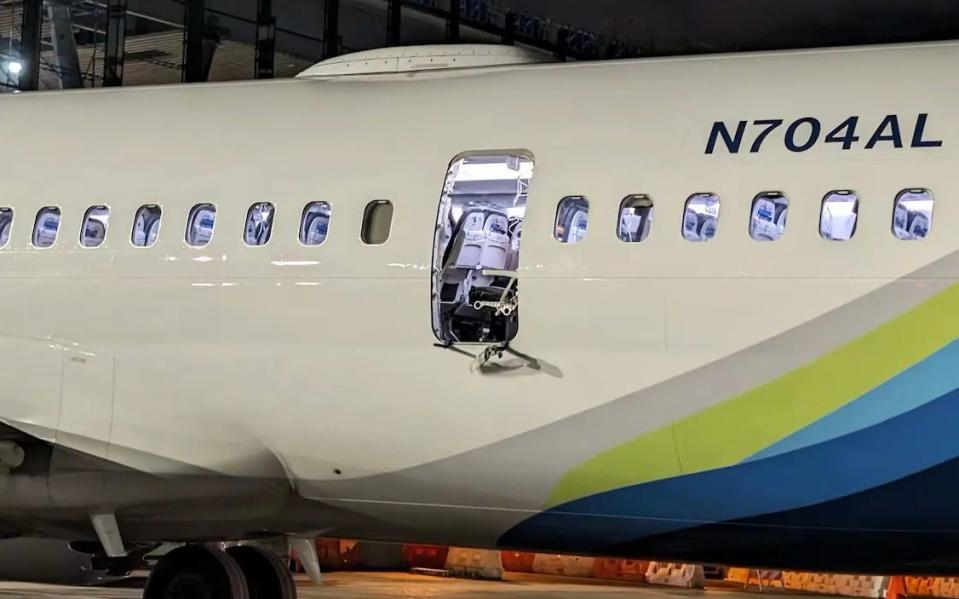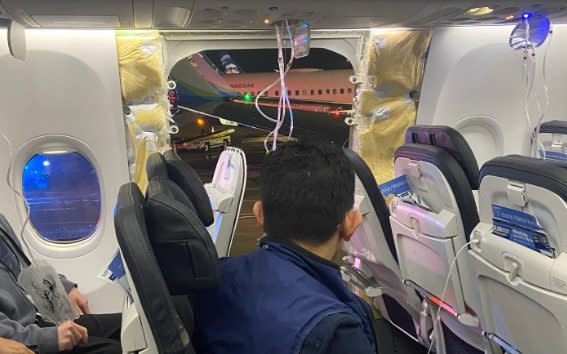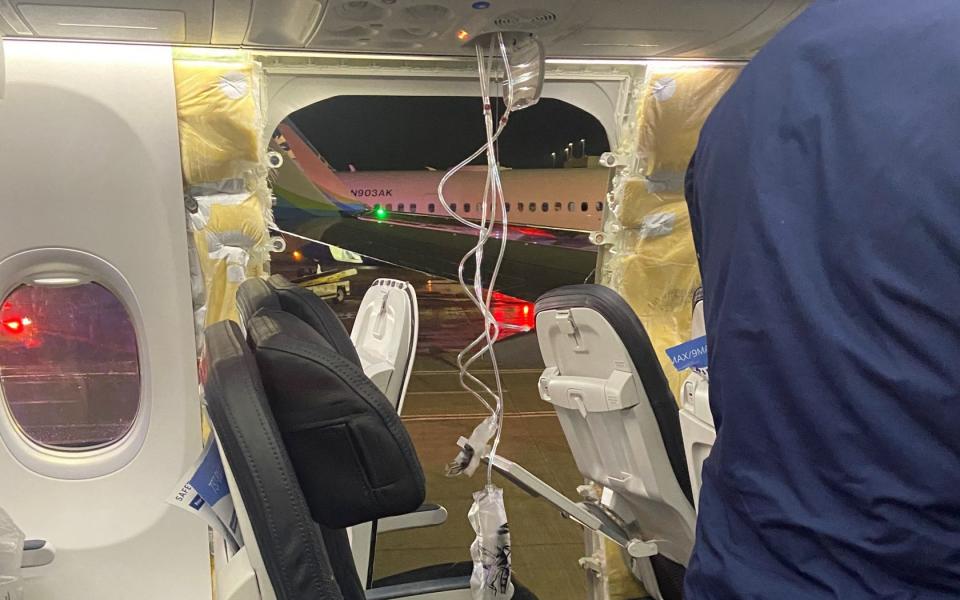Phones, magazines and even the shirt off a child’s back were sucked into the ether after a refrigerator-sized hole opened in the side of a plane mid-flight.
An Alaska Airlines Boeing 737 Max 9 plane had been traveling for about 20 minutes and had reached an altitude of 16,000 feet when part of the fuselage collapsed.
Preliminary investigation on Saturday revealed that the section was a deactivated emergency door built into the aircraft but not in use at the time.
Passengers said their phones and other loose items were ripped from their hands when the cabin became pressurized and were forced to return to Portland for an emergency landing.
A toddler sitting near the hole had his shirt ripped off his back as his mother tried to prevent him from being dragged out of the plane’s cabin.
A passenger said the boy appeared to have lost his shirt and his skin looked red and irritated. Flight attendants reportedly helped the mother and son move to the other side of the plane a few minutes later.

In the emergency call to air traffic control, you hear a woman say: “We are an emergency. We are out of pressure, we have to return.”
Pilots made the emergency landing 35 minutes after takeoff, and about 15 minutes after the part of the plane came loose.
One passenger, Emma Vu, later posted her text messages to members of her family on TikTok.
“I’m so scared right now. Please pray for me,” she said, adding: “Please, I don’t want to die.”
Evan Smith, another passenger, told reporters: “There was a very loud bang towards the left rear of the plane and a whooshing sound – and all the air masks fell.
“They said there was a kid in that row who [had] his shirt sucked off him and off the plane and his mother held him to make sure he didn’t go.
Passenger Diego Murillo said the opening was “the size of a refrigerator,” while another, Elizabeth Lee, described the deafening sound as a powerful wind swept through the cabin.
“Part of the plane was missing and the wind was just extremely loud,” the 20-year-old said. “It was honestly horrifying.”
The whipping winds made announcements over the loudspeaker system inaudible, she added.
Initially, no serious injuries were reported among the 171 passengers and six crew members. One flight attendant reportedly suffered minor injuries.


Passengers who experienced the ordeal were given a free flight by the airline with more legroom and free drinks and snacks.
Alaska Airlines has grounded all 65 Boeing 737 Max 9 planes for testing to ensure the accident is not repeated on any of its other flights.
Ben Minicucci, CEO of the company, said: “Each aircraft will not return to service until full maintenance and safety inspections have been completed.”
“My heart goes out to those who were on this flight – I am so sorry for what you have been through,” he added.
Boeing said it was aware of the incident and is “working to gather more information.”
China’s aviation regulator said it is holding an emergency meeting to consider a response to the incident, including a possible grounding of the country’s Boeing Max fleet.
Images show that the hole that appeared was in the rear third of the plane, behind the wing, where the plane sometimes has an emergency exit.
Alaska Airlines chose not to equip its plane there with an emergency door, and the panel covering the hole in the fuselage appears to have been ripped off.
According to Federal Aviation Administration records, the plane had only been in service for a month and was certified in October.
The incident comes less than three months after Alaska Airlines suffered an attempted hijacking by an off-duty pilot who appeared to be having a psychotic episode.
Joseph Emerson, 44, later said he was under the influence of psychedelic mushrooms when he tried to shut down the plane’s engines and open the emergency exit, believing he was in a dream.
Wearing a seat belt is the key to survival
The Alaska Airlines incident could have been much worse if passengers had not worn their seat belts or quickly fastened their oxygen masks, experts said.
The plane had reached an altitude of 16,000 feet when a piece, described as the size of a ‘refrigerator’, was ripped off.
“This is a very, very serious situation, and it could have been much worse,” said Anthony Brickhouse, an air safety expert at Embry-Riddle Aeronautical University in the US.
The incident underlines the importance of passengers continuing to fasten their seat belts while on a plane, even when the fasten seat belt light is off, he said.
“If someone had been sitting in that seat and it wasn’t secured, it would have been a different situation,” he explained.


In previous incidents, passengers have tragically died after being partially or completely sucked out of broken windows. In 2018, Jennifer Riordan died after being partially sucked out of a window on a Southwest Airlines plane that was struck by debris from a blown engine at an altitude of 35,000 feet.
Passengers are also encouraged to quickly secure oxygen masks if their aircraft becomes damaged.
“It seems to have happened quickly. In this situation the aircraft will depressurize very quickly; the air will flow out, there may be fog in the cabin and certainly a loud noise,” said Prof. Graham Braithwaite, a flight safety expert at Cranfield University in Britain.
“It will be quite dramatic and scary for passengers.”
The incident would have been more serious had it occurred at cruising altitude, Prof Braithwaite added.
The pressure reduction is more powerful at higher altitudes; for example, if the aircraft is flying between 30,000 and 35,000 feet, and it can be more extreme on smaller flights. The greater the damage to the aircraft structure, the faster the decompression rate.
“This was at 16,000 feet, and the cabin would have been pressurized between 8,000 and 10,000 feet, so the pressure difference wouldn’t have been as great as if they were at 30,000 to 35,000 feet,” he explained. “In the cockpit, they want to descend quickly to get the plane to 10,000 feet, where people can breathe normally.”
Oxygen masks at high altitudes are essential to prevent hypoxia. Hypoxia is a condition caused by low oxygen levels in the arterial blood, which leads to confusion and breathing difficulties, and if it persists, it can lead to brain damage.
“If a decompression occurs, it is imperative that everyone on board wears an oxygen mask. The risk of developing hypoxia occurs quite quickly, causing people to lose the ability to think logically,” said Prof. Braithwaite.
The temperature also decreases as the temperature in the cabin becomes equal to that of the outside air. In addition, air flows through the cabin and a mist or mist may descend due to the change in humidity.
Debris and unsecured objects can also fly through the cabin or be thrown from the aircraft, while dust can restrict visibility.
Airline personnel encourage passengers to remain calm and not remove loose personal items from bags or seat pockets. They can also instruct passengers to sit in the brace position and protect their heads from loose objects.

